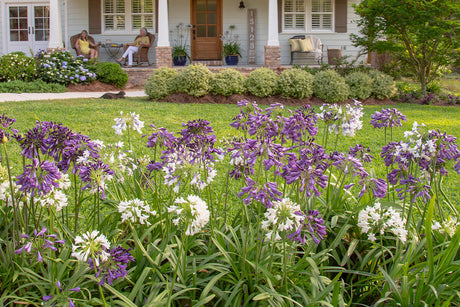

Nandina 101 - Intro to Nandina Plants
|
|
Time to read 4 min
|
|
Time to read 4 min
Welcome to Nandina 101! Nandina plants are a classic choice for Southern landscapes and they have been for quite some time. If you’ve spent any time in the South at all, then you’ve driven past at least one of these southern favorites, even if you didn’t realize it. This is particularly due to the fact that they’re especially resilient, low maintenance, and adapt to sun or shade, moist or dry soils, and cold or hot environments. However, many 21st-century Nandina shrubs are very different from your grandmother’s nandinas. For instance, we offer nandina varieties from the Southern Living Plant Collection. These selections are all compact, colorful, and don’t spread or produce any berries. In this course, we’re going to be covering some of the different ways you can use these modern versions of classics to take your yard to the next level!
The key to using Nandina plants in a landscape or container involves the concepts of texture and color. These are somewhat intricate concepts that gardeners spend years studying and experimenting with, so we’re just going to cover the basics.
Modern-day nandina shrubs make layering a breeze. Unlike traditional nandinas, they’re densely foliated and less leggy. Consequently, they create seamless eye-catching clusters of foliage that you want.
The goal here is to mix plants of different colors and textures to create a compelling display. Foreground shrubs should be shorter than mid or background shrubs, and generally max out at around 2 feet tall. Mid-ground shrubs will traditionally be around 3-5 feet tall. Finally, background shrubs will be the tallest in the display. This sort of arrangement will make it possible for different plants to be easily visible and create interesting dynamics with the plants around it. Create intriguing undulations of foliage in your landscape by pairing plants in the same height category with other plants that contrast in texture, shape, and color.
At 3-4’ tall, the Lemon Lime and Obsession Nandina shrubs are perfect as a mid-height layering shrub. Whereas, the Flirt and Blush Pink Nandina are well suited as a low-layer, foreground shrubs.
The Lemon Lime contrasts perfectly with Loropetalums, such as the Purple Diamond Loropetalum (or Red Diamond Loropetalum). The Purple Diamond is nearly the polar opposite of the Lemon Lime in terms of texture and color, creating a scene that really pops in your landscape. The Diamond’s gorgeous royal purple foliage is evergreen and rounds off at the end, providing the perfect backdrop for a shrub-like the Lemon Lime Nandina, which has pointed, bright lime-green foliage.
Pair Obsession with the low growing, grass-like foliage of the Everillo or Everoro Carex for an impressive texture and color contrast. These faux grasses are the perfect height for planting in front of the Obsession. Furthermore, their characteristic brilliant yellow-green foliage will create a gorgeous display with the bright red and dark green foliage.
For some further reading on landscape layering from Landscaping with Tesselaar Plants, Click Here.
Nandina plantss are ideal for planting next to walls, edges, fences, or anywhere you have a hard edge in your yard. The dense foliage allows for smooth transitions from ground to structure. Notably, try planting them in large groups around birdbaths or fountains to create a seamless spectacle. Choose varieties that will contrast with your structure. For red brick or dark wood, you may want to plant Lemon Lime Nandina. Its brilliant lime green foliage will create a notable contrast. For sandy or lighter bricks, bolder selections such as the Obsession or Flirt Nandina will allow for the most intriguing contrast.
In addition to being evergreen, Nandina shrubs are quite hardy, which makes them perfect choices for container gardens. The naturally compact selections from the Southern Living Plant Collection bring new options to the table for winter containers. One Southern Living container recipe (pictured below) includes a Soft Caress Mahonia, Lemon Lime Nandina, Everillo Carex, and Purple Pixie Loropetalum. Specifically, this evergreen mix would be ideal for a covered patio that receives a couple of hours of the morning sun.
For a summer container, try this mix (pictured below) which brings in plenty of purple, white, and pink. Particularly, this is a sun-loving container and would look ideal in a sunny garden or uncovered patio.
The fortunate thing about these Nandinas is that they are tolerant of different levels of sunlight and types of soils. Therefore, if you have a specific container recipe in mind, chances are that these shrubs will fit right in.
It’s hard to believe this course is coming to an end already. When you started reading this blog post a couple of minutes ago, I knew you had the potential to be one of my best students ever. Fortunately, you didn’t disappoint. As you go forward, please don’t hesitate to Contact Us if you have any questions, and remember to keep on growing!





